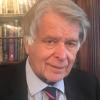Effective treatment of Osteoporosis with Oestrogen
Professor John Studd
Editors comment
Professor John Studd passed away on the 17th August 2021.
The enormous contribution that he made in the area of women's health and to our understanding of the menopause in particular cannot be overstated. He pioneered the use of HRT, setting up the first specialist menopause clinic in Europe in 1969 - in Birmingham. He also co-founded the National Osteoporosis Society, now the Royal Osteoporosis Society.
Total Health had the honour of working with "The Prof" for over a decade and he will be very badly missed. However, his legacy will endure, and a number of specialist consultant gynaecologists who were trained by by him now contribute to Total Health - please click here for further information.
Editor's foreword
Professor John Studd is generally regarded as the leading light in the campaign for women’s medicine and healthcare. He was awarded the Gold Medal of the Royal Society of Medicine for the obstetrician/gynaecologist who has made the greatest lifetime contribution to women's health. He has fought the medical cause on behalf of women and has been proved consistently correct in his views on the important role of hormone therapy. He says that both doctors and patients need to be aware that HRT should be the frontline treatment and that women are best cared for by the appropriate experts i.e. gynaecologists. Oestrogen is proved to be the best treatment to prevent the symptoms of menopause, not to mention the horror of spine fractures associated with osteoporosis. In the meantime big pharma has stepped in to fill the treatment void caused by the discredited 2002 WHI Study with their own alternative products such as the bisphophonates and antidepressants (see - Profox nightmare) and the danger is that these drugs can do more harm than good.
The Royal College of Obstetricians and Gyneacologists website states:
“The effects of HRT have been studied in over a million women worldwide and research shows that for most women HRT works and is safe.”
Why Women can now Benefit from Oestrogen Treatment
“Hormone therapy is the most logical and the most beneficial treatment for low bone density”.
HRT - Altered Opinions
About 20 years ago Hormone Replacement Therapy (HRT) was the only really effective treatment for osteoporosis. However, following the bad news fallout from the 2002 WHI study, oestrogens were subsequently considered not to be the first choice of therapy. Fortunately for women this study has now been totally discredited and retracted even by the investigators. As a result of the WHI study most physicians who are virtually always poorly trained in hormone therapy happily resorted to the use of bisphosphonates, strontium, parathyroid hormone or worse. These treatments may be appropriate for the older patient but for the younger woman on long term therapy there are major side effects including epigastric pain, osteonecrosis of the jaw, femoral mid-shaft fractures and there is also a suggestion of an increase in oesophageal cancer.
The evidence is now clear that the safest and most effective way to increase bone density in women under the age of 60 years is by treatment with oestrogen. The denial of oestrogen to these younger women is tragic when we consider the many younger 30-40 year old women with premature menopause or with a history of anorexia and amenorrhea.
Thin Women Deficient in Oestrogen
Thin women including those with an exercise and / or marathon running addiction, or healthy thin women who consider walking the dog for 2 hours a day sufficient exercise may also be deficient in oestrogen. For these women, the oestrogen deficiency could be due to premature ovarian failure or amenorrhea or simply because they are thin and not producing sufficient oestradiol in their own body fat. In these cases transdermal oestrogen must be regarded as the correct first choice of treatment. Similarly premenopausal women are at risk if they have a hysterectomy and bilateral oophorectomy without appropriate hormone replacement. These women clearly need oestrogen to treat the post oophorectomy symptoms as well as for protection of the skeleton.
Oestrogen Treatment Anabolic for Skin and Spine
There is a decrease in skin collagen sssociated with ovarian failure regardless of age due to lack of oestrogen. Oestrogen therapy will replace the missing hormone and improve the quality of skin thickness and skin elasticity. Equally the loss of collagen also happens in the bone matrix, which is the vital scaffolding and structure of the bone. Oestrogen replaces the missing collagen in the matrix of osteopenic bone. This same anabolic effect upon the collagen protects the intervertebral discs in the spine. The discs make up one quarter of the length of the spinal column and serve as a cushion protecting your spine and preventing the development of vertebral crush fractures. This is why osteopenia or, of course, osteoporosis are major causes of spine fractures. Oestrogens protect the intervertebral discs and bisphosphonates do not.
A Generation to dispel the old HRT Myths
“The most beneficial treatment for low bone density”
Any anxiety about the safety of HRT should have disappeared by now. However, a major problem remains in that the spurious ‘side effect’ of HRT in women is now in the undergraduate textbooks and it will take a generation to get rid of this misinformation. Women may also have regular or even troublesome periods or may develop breast discomfort on HRT. These are relatively minor problems that a gynaecologist can deal with. The problem is that these symptoms are outside of the training of bone physicians and so these doctors will continue to be reluctant to use the most logical and the most beneficial treatment for low bone density.
All the latest information indicates that HRT is safe and is associated with the removal of most of the climacteric symptoms including loss of libido and depression as well as the more obvious hot flushes and sweats.
Oestrogen Implants Preferred
It is safer to use transdermal oestrogens as this route does not stimulate coagulation factors from the liver and does not encourage deep vein thrombosis (DVT), stroke or pulmonary emboli. It does seem that the risk factor in HRT is more with the cyclical or continuous progestogen. Following hysterectomy women can have oestrogens probably with the addition of testosterone without progestogen and data now from two large studies confirm that this is associated with less breast cancer and fewer heart attacks and cardiac deaths.
Women should not be denied this effective treatment
There seems no reason to deny women particularly under the age of 50 years relief of symptoms and protection of osteoporosis by denying them the transdermal oestrogen treatment. It seems that this is an important lesson that many physicians have yet to learn.
Feature pic: South Kent Downs, Bob Davidson
The time of a woman’s life when her ovaries stop releasing an egg (ovum) on a monthly cycle, and her periods cease
Full medical glossaryA condition in which the protein and mineral content of bone tissue is reduced, but less severely than in osteoporosis.
Full medical glossary








